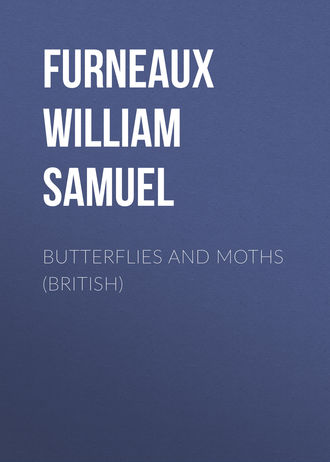 полная версия
полная версияButterflies and Moths (British)

Fig. 110. – The Muslin Moth.
Most of the larvæ of this family feed on the lichens that cover walls and the bark of trees, and they conceal themselves so artfully among this peculiar vegetation that it is no easy matter to search them out; probably many still remain unknown to entomologists.
Our first example – the Muslin Moth – has light brownish-grey and semi transparent wings, the front pair of which have darker markings arranged as shown in the illustration. It is a common moth, and may be met with in July and August.
The caterpillar feeds on lichens in June. It is of a dull grey colour, with a yellow stripe down the back, and has numerous little tufts of light hair.
The Common Footman (Lithosia lurideola)
Fig. 111. – The Common Footman.
The fore wings of this species are of a leaden grey, with a bright yellow costal stripe which dwindles to a point just before it reaches the tip. The hind wings are very pale yellow.
The larva is black, with a reddish line on each side just above the feet. It may be found during May and June among the lichens of oaks, blackthorns, and firs, especially in the woods of the south of England.
The perfect insect flies during July and August.
Family – EucheliidæThe Cinnabar (Euchelia Jacobææ)The family Eucheliidæ contains only four British species, two of which must receive a share of our attention. The first of these is the Cinnabar Moth, which is common in all localities where its food plants – the groundsel (Senecio vulgaris) and the ragwort (S. Jacobæa) – abound.

Fig. 112. – The Larva of Jacobææ.
Its colours are so striking that a glance at its representation (fig. 1 of Plate X) will render a written description quite unnecessary.
The caterpillar is a very familiar and conspicuous object. Its colour is bright orange, broken by several broad black rings; and its body is thinly covered with hair. When fully grown (July or August) it descends to the ground, and there changes to a smooth and shining reddish-brown chrysalis.
The moth appears in June or early in July.
The Scarlet Tiger (Callimorpha Dominula)
Fig. 113. – The Scarlet Tiger.
This is certainly one of the most beautiful of all our moths. Its fore wings are dark olive green, with a lovely metallic lustre, and boldly marked with large white and yellow spots. These spots are arranged generally like those in the illustration, but are subject to great variation. The hind wings are crimson, with large black patches, chiefly distributed near the hind margin. The thorax is black, with two white streaks; and the abdomen crimson, with a black line down the back.
This moth is a common one. It may be taken in June and July. I have seen it flying somewhat freely while the sun was still shining brightly.
The caterpillar is very dark lead colour, nearly black; and is covered with little wart-like projections, from each of which protrudes a short black hair. There is a broad yellow broken line down the back, and two others on the sides. It feeds on the hound's-tongue (Cynoglossum officinale) and many other low-growing plants, hybernates through the winter, and is fully grown in May. Like the other members of this family, it spins a light silken cocoon, in which the hairs from its body are interwoven.
Family – CheloniidæThe Wood Tiger (Nemeophila Plantaginis)
The Cheloniidæ are popularly known as the Tigers – a title suggested by the tiger-like colouring of some of the prominent species. They differ from the Scarlet Tiger and the other members of the Eucheliidæ in that the males have ciliated or fringed antennæ. The larvæ, too, are more densely covered with hair.
The Wood Tiger (fig. 2, Plate X) is a beautiful insect, somewhat variable in its markings, but so conspicuously coloured that our illustration cannot fail to lead to its identification. It may be found commonly among the undergrowth of our southern woods during May and June.
The caterpillar is dark brown or brownish black, covered with little hair-bearing warts. The hairs are long and black on the foremost and hind segments, but shorter and of a brown colour on the middle of the body. It issues from the egg in September, feeds for a week or two on the leaves of violets (Viola canina and V. odorata), heartsease (V. tricolor), plantain (Plantago), or groundsel (Senecio vulgaris), and then hybernates till the following March. It is fully grown in May, and then spins a light cocoon, with which its hairs are interwoven, among the leaves of its food plant.
The Tiger (Arctia caia)This splendid moth is exceedingly variable in its colour and markings, but its usual appearance corresponds closely with that of the illustration on Plate X (fig. 3). In some specimens the cream colour almost entirely covers the fore wings, while in others all four of the wings are completely covered with shades of brown. This insect is probably known to all my readers, for it is abundant everywhere.
The larva is as well known as the perfect insect. It is a kind of universal feeder, partaking readily of almost every low-growing plant, with perhaps a special partiality for dead nettles (Lamium album and L. purpureum). It feeds also on the lime tree (Tilia vulgaris), and is commonly met with on apple trees and on the various plants of our flower beds. The young caterpillar makes its appearance in the autumn, and hybernates after feeding for two or three weeks only. It is full grown in June, when it spins a silken cocoon, and changes to a shiny black chrysalis.
The ground colour of the larva is black, but it is covered all over with long hairs, those down the middle of the back being grey, and the others brown. This familiar larva is known popularly as the Woolly Bear.
The Cream-spot Tiger (Arctia villica)There is yet another Tiger – the Cream-spot – too beautiful and too common to be excluded from our list. It is represented on Plate X (fig. 4); and, like the others of its genus, is so boldly marked that mistaken identity is impossible.
It is a very sluggish moth, more often seen at rest than on the wing, and will suffer itself to be roughly handled without making any attempt to escape.
The caterpillar may be observed on sunny banks, generally feeding on chickweed (Stellaria media) but sometimes on various other low-growing weeds, including the dock and the dandelion. Its colour is black, with red head and legs, and its body is covered with long brown hairs. It commences to feed in the autumn, hybernates throughout the winter, and is full grown in May, towards the end of which month it changes to a black chrysalis within a light silken web.
The perfect insect appears in June.
The Buff Ermine (Spilosoma lubricipeda)The Cheloniidæ also include three moths that are popularly known as the Ermines, two of which – the Buff and the White – are exceedingly common, and are among the constant visitors to our gardens during June and July.

Fig. 114. – The Buff Ermine.
The Buff Ermine has all four wings of a buff or ochreous tint, and spotted with black as here represented.
The caterpillar is whitish, with a white line down the middle of the back, and its body is covered with long light brown hairs. It feeds on the dock (Rumex) and many other low-growing plants during August and September, and spends the winter in the chrysalis state, lying within a loose cocoon on the surface of the ground.
The White Ermine (Spilosoma Menthastri)
Fig. 115. – The White Ermine.
In this species the wings are of a pale cream colour, and the dots of the fore wings are more uniformly distributed than in the last. Its habits and life history closely correspond with those of Lubricipeda, and its larva may be found feeding on the same plants.
This latter may be distinguished from the caterpillar of the last species by the dark brown or black colour of the body, and the presence of an orange line down the back. It is covered with long brown hairs.
Family – HepialidæThe five species which compose this family are known as the Swifts, a title which they have earned by their rather rapid flight. Their wings are narrow, and the antennæ very short.
In the larval state they are long, naked and unsightly grubs, that live under the surface of the ground and feed on the roots of plants. The chrysalides are armed with short spines projecting from the segments.
The Ghost Swift (Hepialus Humuli)
Fig. 116. – The Ghost Swift – Female.
One of the commonest of these moths is the Ghost Swift, which may be seen in hundreds on waste places in the south of England during the month of June. The wings of the male are white, with a silky gloss, and a very narrow brown margin. The fore wings of the female are yellow, marked with irregular reddish lines. The hind wings are of a dull smoke colour.
The larva is pale yellow, with a brown head, and a brown horny plate on the front of the second segment. It feeds throughout the winter on the roots of numerous plants, including the dock, dandelion, burdock, white dead nettle, black horehound, and the hop.
The Common Swift (Hepialus lupulinus)
Fig. 117. – The Common Swift.
The fore wings of the male of this species are brown, with a bent whitish streak, sometimes broken, passing from the base to the middle of the inner margin, and then to the apex. The hind wings are smoke coloured, with a light brownish fringe. The female is much less distinctly marked, and presents a rather dingy appearance.
The larva is dingy white, with brown horny plates on the second, third and fourth segments. It feeds on the roots of dead nettles (Lamium album and L. purpureum), black horehound (Ballota nigra), and various other herbaceous plants, throughout the winter months, and is full grown in April.
This insect is abundant everywhere in waste places, and may be seen on the wing in May and June.
Family – CossidæThe members of this family have longer antennæ than the Hepialidæ, and the females are provided with extended ovipositors which enable them to place their eggs in the deep crevices of the bark of trees.
The larvæ are naked or only very slightly hairy, and have a plate on the second segment. They feed on the wood of trees or the interior of the stems of reeds. The pupæ have spiny projections on each segment.
The Goat Moth (Cossus ligniperda)There are only three British species of this family, the largest of which is the Goat Moth, so called on account of the characteristic odour of the larva, an odour said to resemble that emitted by the goat.
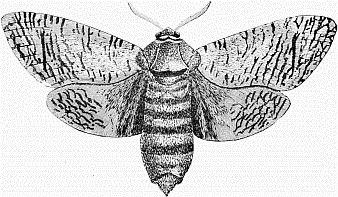
Fig. 118. – The Goat Moth.

Fig. 119. – The Larva of Ligniperda (less than half full size).
The fore wings of this fine moth are pale brown, clouded with white, and marked by numerous wavy transverse lines. The hind wings are somewhat similar, but of a duller tint, and the markings are less distinct. Its average breadth from tip to tip is over three inches, and it sometimes reaches nearly four inches.
The larva is a most interesting creature. It is dark reddish brown on the back, and flesh colour beneath; and its head is intensely black. It feeds on the solid wood of the willow, poplar, oak, elm, and other trees. The infected trees are often so riddled with the burrows of these larvæ that they are completely destroyed, and the presence of the intruders is frequently indicated by a heap of small chips of wood lying on the ground near the roots. The odour of the larvæ, too, is so powerful, that there is generally no difficulty in ascertaining their whereabouts by it alone.
It is not always in living trees, however, that we find these creatures, for they often feed on rotting wood, such as the remains of old palings and posts, that lie on the ground in damp places.
When fully grown they construct a strong cocoon of chips of wood, bound together by silk, and within this they change to the chrysalis.
The moth emerges in June or July, and is commonly found resting on the bark of willows and poplars during the daytime.
The Leopard Moth (Zeuzera pyrina)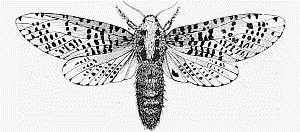
Fig. 120. – The Leopard Moth.

Fig. 121. – The Larva of Pyrina (only partly grown).
The wings of this species are white and semi-transparent, and marked with numerous bluish-black spots in such a way as to remind one of the skin of the leopard. Its body is very long, and the antennæ of the male are doubly fringed for about half their length from the base.
The caterpillar feeds on the wood of various trees – elm, apple, pear, ash, alder, poplar, horse chestnut, birch, lilac, and several others. It is yellowish, with black shiny spots, and a black plate on the second segment.
The moth appears in July, and is widely distributed. It is attracted by bright lights, but the best way to obtain it is to search the trunks and branches of trees that are known to harbour the larvæ early in the morning, and so obtain newly emerged specimens.
Family – LiparidæPassing over the two small species which are the only British representatives of the family Cochliopodidæ, we come to the interesting Liparidæ, the remarkable feature of which is that most of the caterpillars are adorned with brush-like tufts of hair, and even the chrysalides are hairy.
The perfect insects are not brilliantly coloured, but generally display very pale tints; and the antennæ of the males are pectinated or feathered.
The Brown Tail (Porthesia chrysorrhœa)
Fig. 122. – The Brown Tail.
The family contains two moths – the Brown Tail and the Yellow Tail – that are very similar in appearance and habits. Both have white wings, and their bodies also are white with the exception of the tuft of coloured hair at the tip of the abdomen, which gives the names to the species. Their larvæ may both be found feeding on the same trees (whitethorn), and both change to a brown hairy chrysalis within a loose cocoon among the leaves.
The larva of Chrysorrhœa is black, with four rows of little wart-like projections on each side, from which proceed little tufts of hairs. These hairs are reddish with the exception of one row on each side, which is white. The tenth and eleventh segments have each a scarlet tubercle, and there are also other small spots of the same colour on some of the front segments.
The larva feeds on the blackthorn in addition to the tree mentioned above, and is full grown in June. The moth flies in August.
The Gipsy (Ocneria dispar)
Fig. 123. – The Gipsy – Male.
The fore wings of the male are smoky brown, with darker markings, including a V-shaped black mark near the centre. The hind wings are brown, darker near the margin. The female is dingy yellowish white, with darker markings arranged as in the male. The male is much inferior in size, and its antennæ are very strongly pectinated.
The larva is brownish black, finely dotted with yellowish grey. There is a grey stripe down the middle of the back, and six tubercles on each segment give rise to tufts of long hair. It feeds on the whitethorn (Cratægus oxyacantha), blackthorn (Prunus spinosa), and various fruit trees.
The caterpillar is full grown in June, and the moth appears in August.
The Black Arches (Psilura Monacha)
Fig. 124. – The Black Arches – Male.
The fore wings of the Black Arches are white, marked with zigzag black lines as shown in our illustration. The hind wings are smoky grey. The hinder segments of the abdomen are banded with black and rose-pink. The male is much smaller than the female, and has the antennæ strongly pectinated.
The caterpillar is hairy, and of a greyish-white colour. A brown stripe runs down the back. On the top of the second segment are two blue tubercles; and there is also a tubercle, of a reddish colour, on each of the ninth, tenth, and eleventh segments. It feeds on the oak, birch, fir, and the apple; and is full grown in June or July.
The moth flies during July and August.
The Vapourer Moth (Orgyia antiqua)
Fig. 125. – The Vapourer Moth – Male.
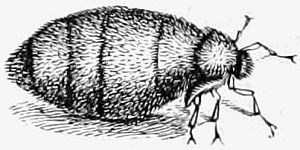
Fig. 126. – The Female Vapourer.
During the hottest summer months, and particularly in August and September, a rather small brown moth may be seen almost everywhere, flying rapidly and in a very erratic manner in the bright rays of the midday sun. This is the common Vapourer Moth, which may be known at once by its bright chestnut colour, with darker transverse markings, and a white crescent-shaped spot in the anal angle of the fore wings. It seems somewhat partial to civilised life, for it frequents the streets of our metropolis, even in the very densely populated parts; and the larva is one of the commonest of the insect forms infesting our gardens and squares.
The caterpillar is variously coloured; but the prevailing tints are dark brown, grey, and pink. On the second segment are two long tufts of hair directed forward, and on the twelfth segment a similar tuft directed backward. On each of the segments five to eight inclusive is a brush-like tuft of yellowish hairs. It feeds on almost every tree usually to be found in parks and gardens.
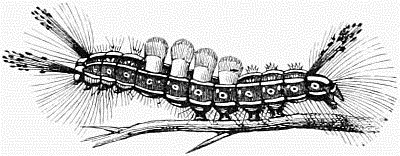
Fig. 127. – Larva of the Vapourer Moth.
When fully grown it spins a web on the bark of a tree, or on a wall or fence, and changes to a hairy chrysalis.
The female of this species is wingless, and never moves away from the cocoon out of which she has crawled, but lays her eggs on the outside of the silken web, and there remains to die.
The clusters of eggs may be found in abundance throughout the winter months.
Family – BombycidæThis family contains eleven thick-bodied moths, mostly of large size, in which the predominating colours are greys and browns. Their hind wings are generally paler than the front pair, and less distinctly marked; and the antennæ of the males are pectinated.
The caterpillars are very hairy, but the hairs are uniformly distributed, and not arranged in tufts as in the larvæ of the last family.
The chrysalides are inclosed in silken cocoons, but are not hairy.
We shall briefly examine three of the members of this family.
The Oak Eggar (Bombyx Quercus)The male of this species is shown on Plate X (fig. 5). The female is much larger, and of a pale tawny colour.
The ground colour of the caterpillar is black; but it is so closely covered with short yellowish brown hairs that the black is scarcely visible, excepting when the creature rolls itself up into a ring, which it does when alarmed. The spiracles are white, and there is a series of white spots down the middle of the back and along each side. It feeds on whitethorn (Cratægus oxyacantha), heather (Calluna, Erica), poplar (Populus nigra), and various other plants and trees.
As a rule the larva hybernates through the winter, is full grown in the following May, and the moth appears in July; but in Scotland the caterpillar does not spin its cocoon till September, hybernates in the chrysalis state, and emerges in the following June. The same is true of the Cornish Eggars; but along the coast of South Devon both varieties are to be met with.
The male Eggar seems to enjoy the bright sunshine, for I have seen large numbers flying over the rugged cliffs of the south-west throughout all hours of the day.
The Drinker (Odonestis potatoria)The popular name of this species is applied on account of a peculiar feature of the larva, which sucks up the dewdrop that lies on its food plant.
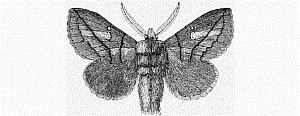
Fig. 128. – The Drinker – Male.
The colour of the male is tawny and brown, with a reddish tinge; that of the female is yellow. The front wing has an oblique dark bar passing from the apex to the middle of the inner margin; also two white spots – one in the middle of the wing, and the other between it and the costal margin.
The caterpillar is dark bluish grey above, and has a line of orange spots on each side. Along the spiracles are oblique orange streaks, and a series of tufts of white hair. It feeds on the annual meadow-grass (Poa annua), and several other grasses. It is a hybernator, commencing its caterpillar state in the autumn, and reaching its full dimensions about the end of the following May.
The moth flies during July and August.
The Lappet (Lasiocampa quercifolia)Our last example of the Bombycidæ is the Lappet (Plate X, fig. 6), a large moth, the female often measuring considerably over three inches from tip to tip. The wings are of a rich reddish brown, and exhibit a beautiful purplish bloom in a newly emerged insect. Scalloped black lines pass transversely across each wing, and a small black dot lies near the centre of the fore wings.
The caterpillar is very variable in colour, but is usually grey or reddish brown. A deep purple band lies between the second and third segments, and another between the third and fourth. On the twelfth there is a small hump, and a pale stripe, more or less distinct, runs along each side. It feeds on the blackthorn (Prunus spinosa), buckthorn (Rhamnus catharticus), and the white willow (Salix alba).
The moth is not uncommon, and is on the wing in June.
Family – EndromidæThe Kentish Glory (Endromis versicolor)The beautiful Kentish Glory is the only British representative of its family. The male is shown in Plate X (fig. 7); the female is larger and similarly marked, but its colours are not so bright.
This moth is not common, but may be seen occasionally in the birch woods of the southern counties. The males fly rapidly in the bright sunshine, but the females must be searched for on the bark and branches of the trees.
The eggs are laid in April on the twigs of the birch (Betula alba), and the young caterpillar emerges early in May. It is gregarious at first, but loses its social tendencies as it gets older. When full grown, it is of a pale green colour, with white spiracles, a dark green line down the back, and an oblique white stripe on each side of each segment. The sides are dotted with black and brown, and there is a conspicuous hump on the top of the twelfth segment.
When fully grown it spins a cocoon among the dead leaves beneath the tree, and in this it spends the winter months in the chrysalis state.

